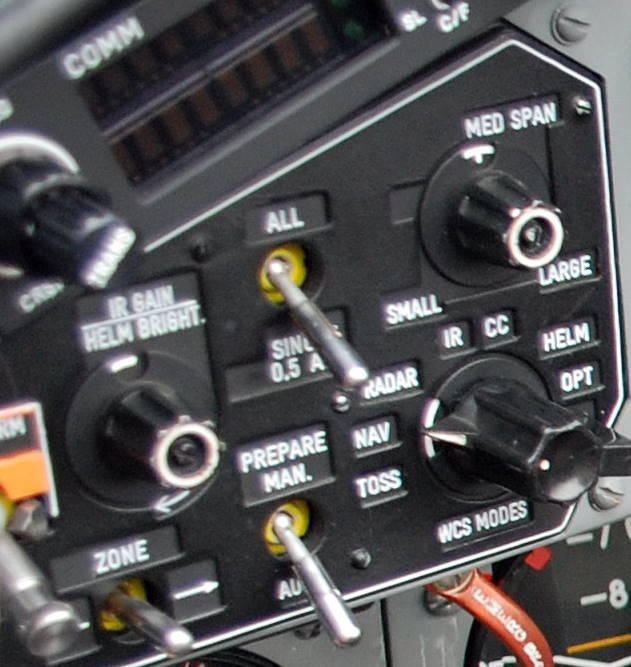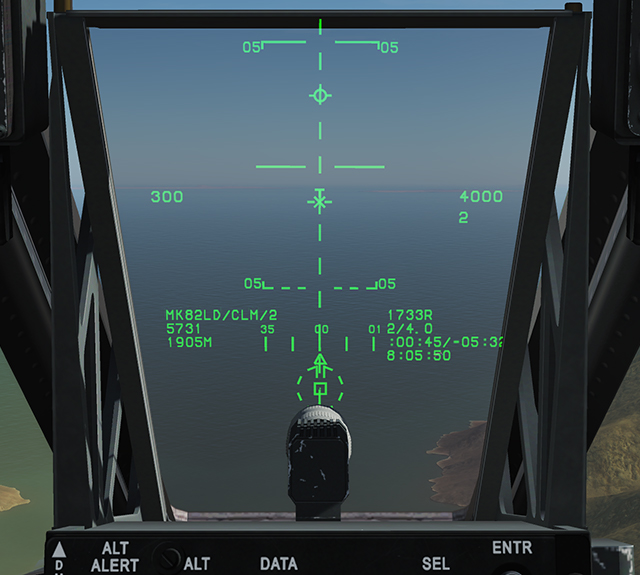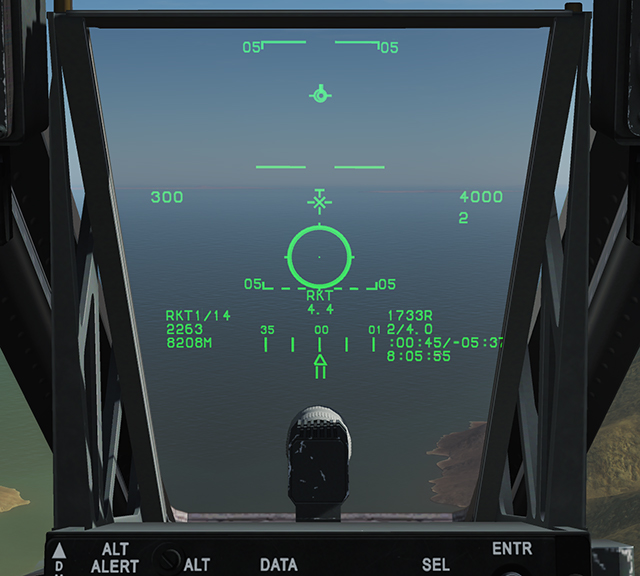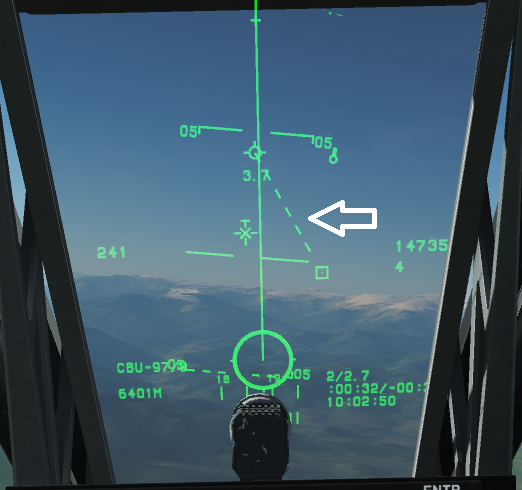-
Posts
155 -
Joined
-
Last visited
Content Type
Profiles
Forums
Events
Everything posted by N22YF
-
My first button box build! When I was figuring out what to do, I found it really helpful seeing what others had done, so I thought I’d share mine in case it might be helpful for people considering doing something similar. This button box is for the left-cockpit off-throttle controls for the Flaming Cliffs 3 aircraft; I modeled it after the Su-33’s cockpit, since that’s the FC3 aircraft that has the most left-cockpit off-throttle controls, but I laid it out so it works well for most or all of the left-cockpit off-throttle controls of all the FC3 aircraft. (I play in VR, so it’s not confusing having the wrong labels when I fly other aircraft - the labels are just for fun since I can’t see them in VR anyway.) I have to say, it feels so much better to use what’s basically the actual controls for these aircraft rather than just pressing buttons on the throttle or keyboard to accomplish the same actions! And it's much easier than groping for the keyboard in VR. I’m using a Leo Bodnar BBI-32 board with 32 inputs: 3 single-throw toggle switches (including the landing gear lever) 4 single-throw momentary toggle switches (including the landing lights switch) 2 double-throw momentary toggle switches 9 momentary buttons (used e.g. for autopilot controls on the Su-25T, Su-27/33, and MiG-29) An interlock pushbutton switch with two buttons (pushing one button will "unpush" the other button - used for flaps, for aircraft with only two flaps settings) A 5-position rotary switch (used e.g. for setting operating mode on the Su-27/33, MiG-29, and A-10A) A regular rotary encoder A rotary encoder with an integrated momentary push button and I use Joystick Gremlin to do things like sending the command when a switch is moved, so I can map the on and off movement of single-throw switches to two commands. (Honestly a VIRPIL throttle would have gotten me most of the way there with a lot less work, but they’re always sold out and I haven’t been able to order one, so… here we are!) This was a pretty fun learning process - I learned how to use Fusion 360, how to use a laser cutter, and how to 3D print. The button caps, the mode select knob, the landing lights switch cap, and the landing gear lever are all 3D printed. The faces of the panels are three layers of 3 mm laser-cut acrylic, so that I could get the top of the toggle switch bases flush with the panels. The top layer is white acrylic that I spray-painted black and then etched away the paint with the laser cutter. (The button labels are done the same way - they’re acrylic inserts that drop into the top of the button caps.) I thought about replicating the Su-33’s blue cockpit colors, but doing three colors (white, black, and blue) was much more complicated than two, so I went with just black and white since I can’t see it anyway in VR. The base, which allows for my TWCS throttle to be attached aft of the button box, is 6 mm plexiglass, and I have the whole thing mounted on a J-PEIN desk mount. The side panels are ¼" thick Delrin (also cut on the laser cutter, and then spray-painted matte black), which was easy to drill into so I could screw the whole thing together. I have a new appreciation now for the price of higher-level sim gear (such as the Warthog throttle) now - I spent close to $100 (over $100 with shipping) on switches and encoders etc. alone (and that’s not including about $50 for the Leo Bodnar board)! Here's a video demonstrating it in action: Here's a shot with 2 of the 3 panel layers removed: Here's how I use it with the Su-33: And with the F-15C:
-
Bassel Al-Assad? Very exciting! Looking forward to seeing more! Isn't Bassel Al-Assad in Syria (where Khmeimim Air Base is) and not Lebanon, though? Or is there another Bassel Al-Assad in Lebanon?
-
Yeah it's hard enough to make sense of Russian technical documents, and now we've got Ukrainian! :hmm: At the bottom of page 6 (slide 61), in the list of the different settings of the RLS MODES (РЕЖИМЫ РЛС) dial, it says: which translates to "AUTO - automatic switching HPRF - MPRF". Regarding the variation of repetition frequencies within HPRF or MPRF, the table on slide 7 shows that HPRF uses 160-220 kHz and MPRF uses 16-30 kHz (BVR) or 21-28 kHz (WVR). I noticed in the "automatic guidance" section it says (page 4 slide 40, rough translation): I'm thinking that this isn't referring to the СНП switch, though, since it doesn't actually mention the switch (unlike other discussions of controls). I'm thinking this is related to GCI operations? This is the only other mention I could find of ППС/ЗПС, though, aside from the РППК thing. (I think that must be a typo - if you do a Google search for "РППК" "МиГ-29", the only relevant result is that one sentence in this document.) Then in the "manual guidance" section (page 4 slide 41, rough translation):
-
That's true! But it's also odd that "RPPK" doesn't appear anywhere else in that whole document. And what would RPPK be? :confused: But why would the automatic/manual lock option be tied to PRF? :confused: But auto PRF is not a standard function of SNP, right? Ah! Good to have another pair of eyes vetting sources, thanks! What did you see in the rest of the page that leads you to discount it? I've only read bits of pieces of it.
-
Thanks for this thorough report - hopefully ED sorts this out! I also noticed that if you turn on your landing light, your wingmen will do the same, but not for the taxi light. Just wanted to add that, according to the F-15A/B/C/D flight manual, light stage (D)—that is, anti-collision lights only—is not possible. Whenever the anti-collision lights are on, the position (nav) lights automatically go to steady full brilliance, regardless of the position of the position (nav) lights knob. Also, the position (nav) light options in the real F-15C are: off; steady at adjustable brightness; and flashing at full brightness. So, RCTRL+L should more accurately cycle nav lights between off, steady, and flashing, with the current setting being temporarily overruled by steady whenever anti-collision lights are toggled on with RCTRL+RALT+L.
-
Yes I'm also guessing it's a typo and they meant RLPK. The RPPK abbreviation doesn't appear anywhere else there. (That does suggest that that switch controls PRF, though, which is not what I've read elsewhere - but if that's true, I don't understand how that control would interact with the radar mode control which also sets PRF.) According to this page (scroll to the RPLK-29 [another typo!] section): which implies auto PRF is available only with SNP! Also, this extensive and aptly-titled article "Everything You Need to Know about the MiG-29 Fulcrum" says, in its description of the various radar modes: However in the same paragraph, it goes on to say: which implies that AUTO (АВТ) mode can be used with or without TWS (СНП), depending on this switch position. :confused:
-
Ah, I thought you were talking about in DCS (FoxAlfa's original post is regarding a bug where you're switched to АВТ uncommanded while in СНП in a specific situation, when in DCS you shouldn't ever be able to be in АВТ in СНП in the first place). On the real-life MiG-29, my understanding is you actually can use СНП in АВТ mode. Maybe that's one to add to the list? Ah, if you were also referring to the real-life MiG-29, then yes, АВТ is the radar mode and СНП is more like a sub-mode! But I think Ironhand was also referring to in DCS? :confused:
-
Are you using MadDog's patched version of the Sea Dragon campaign? He's fixed many bugs. https://www.digitalcombatsimulator.com/en/files/3303252/
-
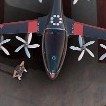
Su-33 Black Sea serpent, unable to locate tanker for refuel
N22YF replied to LeoMaverick's topic in DCS: Flaming Cliffs
In addition to Ironhand's great suggestions, you can also use the AWACS to help you locate the tanker. In the AWACS communications menu, choose 1 (124 Mhz) and then choose option "vector to tanker." -
In the unguided bomb delivery modes, the manual says the HUD shows the terrain elevation under the selected weapon type (in the data block in the lower left corner). However, the number here appears to be MSL+AGL (in feet), instead of terrain elevation which would be MSL-AGL. Without a target locked, this readout is MSL+AGL of the aircraft at the moment; with a target locked, it changes to (current MSL) + (current MSL - target elevation). Here are some screenshots - you can see radar altitude = 1733 ft and altitude MSL = 4000 ft. Without a target locked, the "terrain elevation" readout is 5731 which is roughly 4000+1733: (You can also see this on the HUD image on page 50 of the DCS A-10A manual: the MSL altitude is 1812 ft, the radar altitude is 1795 ft, and the "terrain elevation" readout is 3608, which is roughly 1812+1795.) When I lock on the ocean ahead, the "terrain elevation" readout changes to 7998, which is roughly 4000 (MSL) + 4000 (AGL): In rockets and gun modes, this second line correctly shows terrain elevation (MSL-AGL) instead of MSL+AGL. However, while my understanding of the manual is that this number should be the terrain elevation where the weapon pipper is pointed, it's actually the terrain elevation underneath the aircraft. See this screenshot - I'm at 4000 ft MSL and the radar altimeter is reading 1733 ft. While the weapon pipper is pointing at the ocean (elevation of 0), the second line reads "2263" which is roughly 4000-1733 - that is, the terrain elevation below me. This issue also applies to the unguided bomb delivery modes described above, when no target is locked (that is, in that case, this second line is also being computed at the aircraft's position rather than at the location of the pipper). (The target elevation readout does appear to be correct in AGM-65 mode: it shows the terrain elevation for the point the reticle is over.) Finally, in a related issue, the third line of this data block, the slant range, is given in meters (e.g., 8208m in the above screenshot). This should probably be in feet since the other distance readouts on the HUD (distance to the next waypoint and the range numeric under the reticle) are in nautical miles; my understanding is, in the real-life A-10A, these can be selected to be either all in meters and kilometers, or all in feet and nautical miles, but not a combination. However, I don't think a slant range readout even exists there in the real-life A-10A's HUD - maybe better to just remove it? So to sum up, the issues are: In the unguided bomb modes, the target elevation is wrongly calculated as MSL+AGL instead of MSL-AGL. In rocket mode, gun mode, and bomb mode without a target locked, the target elevation is calculated using the aircraft location instead of the location at the pipper. The slant range on the third line of this data block should probably be given in feet (or just removed). (I'm running 2.5.5.41371.1 stable.)
-
Thank you! I was worried that might be a bug, because ED has so much on their plate that I doubt we'll see a fix for a long time :( I'll look into it some more and probably collect some screenshots and post a bug report. The DCS A-10A manual claims those numbers are "terrain elevation and distance under the pipper" in meters, and the HUD diagram labels one of them as "Slant range to impact point in m." (When guns or rockets are selected, the middle number is described as "the barometric elevation, in meters, of the terrain below the weapon pipper" and the bottom number is described as "the range in meters to the terrain point underneath the weapon pipper".) In the real-life A-10A, I believe there is only one number here, which is the target elevation (selectable in either feet or meters).
-
Thank you for your response! However, I didn't quite understand your explanation (or maybe I didn't explain myself well in my initial post) - in your video, you can see this dashed line between the velocity vector and the cueing marker from when the cueing marker begins descending at 1:27 until the bomb releases at 1:40 (even though the cueing marker is well-aligned with the PBRL - although my understanding is, it's important only that the cueing marker hits the middle of the pipper, regardless of how well it follows the PBRL), and again from 3:11 to 3:25. This dashed line never becomes solid - it's either not present, or it's dashed. (I'm not talking about the PBRL, which is the solid vertical line.) (By the way, the SPI is only an A-10C thing; while of course the A-10A can designate targets, that's not the same thing as "setting a SPI" in terms of systems interactions, so it's not quite correct to refer to the designated target as the SPI in the A-10A.)
-
Hello everyone! I have a couple questions about the A-10A HUD symbology that I wasn't able to figure out from the manual. First off: what's this number between the selected weapon and the slant range in meters (26909 in the below screenshot)? As far as I can tell, it's the sum of my MSL and AGL altitudes in feet, but... why?? How is that useful? My second question is: why is there sometimes a dashed line between the velocity vector and the cueing marker in CCRP mode? What's it trying to tell me? Thanks!
-
Thank you! As far as I can tell, this issue seems pretty constant throughout flight and does not seem to be related to what the aircraft is doing (AoA, Gs, etc.), so I wouldn't expect it to be correlated with slats actuation.
-
Flanker flaps movement blipping I have an issue where when I fly the Su-27, Su-33, or J-11, the "Flaps Movement" effect is continuously blipping, which is very annoying. I haven't noticed this with any other aircraft. I'm running DCS stable 2.5.5.41371.1. Is way to solve this issue? Here's a demonstration: Thanks!
-
Ah, false alarm. For some reason that works some of the time but not all the time - I haven't been able to figure out what specific situations allow it to work. :(
-
Minor correction: the Su-30 in the game is the older Su-30KN, not the Su-30SM (see this thread). Also, despite the similar weapons load, it would not be trivial for ED to add the radar and guidance functions you'd need to operate these additional weapons in a flyable aircraft (new MFDs, upgraded radar with new modes, etc.).
-
Thanks for your great work on this! :) I noticed the ADI button is still not lighting up - are there plans to fix that? Thanks!
-

Bug: DCS thinks BLUFOR MiG-29A/Gs land on takeoff
N22YF replied to N22YF's topic in MiG-29 for DCS World
Nope, not for me: There is still something odd since the score window says "takeoff" right when the mission starts, but I don't get "landing" as well, and there's no "Arrival. Parking" message or "taxi to parking area" ATC transmission. -

Bug: DCS thinks BLUFOR MiG-29A/Gs land on takeoff
N22YF replied to N22YF's topic in MiG-29 for DCS World
Oops, so it is! I tried to search to see if this had been brought up before but I guess I wasn't creative enough in my search terms. Thanks! Good to know I'm not the only one experiencing this issue, I suppose. Also I should add that this is an issue if you're set to takeoff from ramp or takeoff from parking hot in addition to being set to takeoff from runway, and it happens with player-controlled aircraft but not AI.






